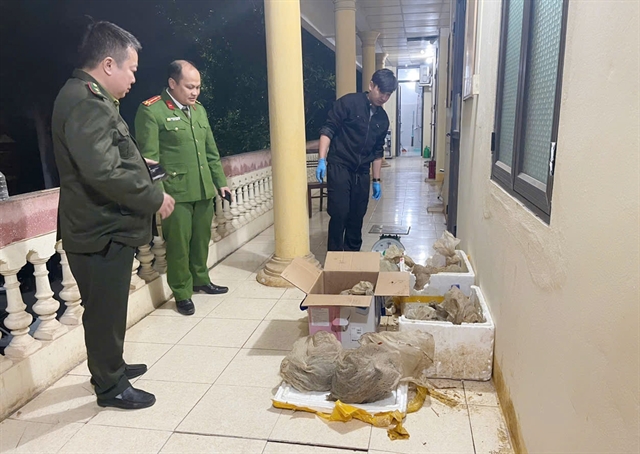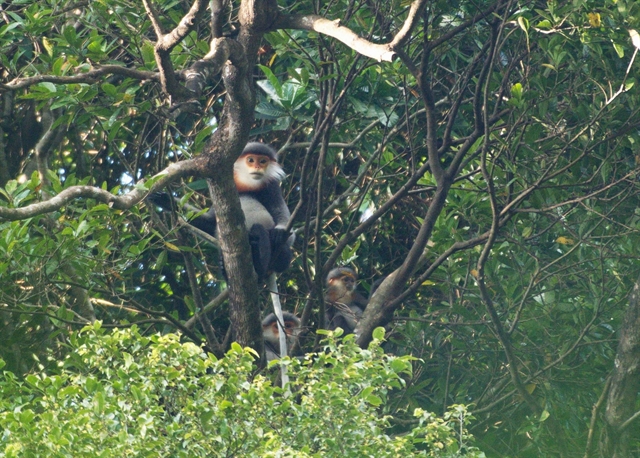 Environment
Environment

 |
| The opening ceremony of the 8th Asian Primate Symposium on Monday in Hà Nội. —Photo courtesy of the Vietnam National University of Forestry |
{ "id": "5DpaKTId6A", "type": "myToolImages", "data": { "data": "" } }
HÀ NỘI — The opening ceremony of the 8th Asian Primate Symposium, the largest of its kind in the region, took place in Hà Nội, providing a platform for experts and stakeholders to discuss challenges and measures for the conservation of primate species in the region.
The four-day event, which commenced at the Việt Nam National University of Forestry on Monday, involves representatives from the Ministry of Environment and National Resources, the Vietnam Administration of Forestry, the Việt Nam National University of Forestry (VNUF), and the international organisations including WWF and IUCN Việt Nam.
VNUF President Phạm Văn Điển said he hopes the event will provide primate experts and stakeholders with a vibrant social environment where they can share their findings, views, and ideas regarding diverse topics, ranging from ethology, ecology, genetics, taxonomy to conservation.
“The symposium also promotes collaboration, partnership, and networking and represents as well an excellent forum to explore new funding opportunities for joint proposal development,” he said.
Trần Thế Liên, director of the Science Technology and International Cooperation Department under the Vietnam Administration of Forestry, said over the past 60 years, Việt Nam has developed legal systems on nature conservation to better protect primate species.
With high awareness of the importance of primate conservation, Việt Nam issued the Urgent Conservation Action Plan for Primates in Việt Nam to 2025, Vision 2030 with many activities including the establishment of the national parks and centres in localities including Cúc Phương, Cát Bà.
Liên said findings and discussions from the event will help management agencies and experts gain a deeper understanding of the status of primates and the challenges in preserving them.
 |
| Grey-shanked douc langurs in Hòn Dồ mountain area, Quảng Nam Province. — VNA/VNS Photo Đoàn Hữu Trung |
Talking about the urgent action plan, Tilo Nadler, founder of the Endangered Primate Rescue Center in Cúc Phương National Park said the remaining tasks until the completion of the action plan are now gigantic and will require a drastic change in its implementation approach.
{ "id": "RuKW38aIfK", "type": "myToolImages", "data": { "data": "" } }
{ "id": "lOG456xXBr", "type": "myToolImages", "data": { "data": "" } }
During the event, experts will discuss three main topics of human and non-human primate interaction and conflicts; behaviour; and conservation and education.
Issues covered at the symposium range from the role of women in primate conservation science in Indonesia, developing the capacity of young researchers in primate conservation in Việt Nam to the community-led conservation action for gibbons in Cambodia, and the use of thermal imaging with unmanned aerial vehicles in monitoring threatened primate communities in Việt Nam.
In Southeast Asia, Việt Nam has the highest number of primates with 24 species and 26 taxa, followed by Laos with 18 species, Thailand and Myanmar with 17 species each, and Cambodia with 13 species.
Việt Nam also has the highest number of threatened primate species. Twenty-two species, or 90 per cent, are threatened with extinction, of which 10 species (42 per cent) are ‘Critically Endangered’ and at risk of extinction, including the three species endemic to Việt Nam, the Delacour’s langur (Trachypithecus delacouri), the Cát Bà langur (Trachypithecus poliocephalus) and the Tonkin snub-nosed monkey (Rhinopithecus avunculus). — VNS



